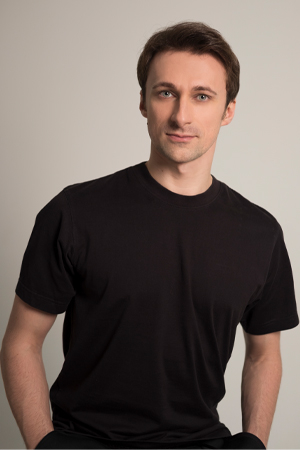
But the dancer appeared, he barely slanted his shoulders and we were face to face with the puppet first brought to life by Nijinsky and subsequently by many great dancers. There was indecision in every move. And there is also persistence, the haughtiness of a poet. And a wild lack of belief in himself. In this Pétrouchka’s veins it was reflection and not blood that flowed; and he banged on the invisible walls in such a way that it was as if we were looking at a fortress.
Vremya novostei
Mariinsky Theatre dancer Filipp Stepin (Basilio) is super-graceful, refined and powerful, and his dance is energetically infectious and full of fire, yet at the same time not uncontrolled – in him one can sense beauty of style and understanding of that style...
Belcanto.ru
Valeria Martynyuk and Filipp Stepin danced the Act I peasant pas de deux with style and accuracy. He is tall and well mannered, with impressive double tours and nicely pointed feet.
DanceTabs
Born in Leningrad.
Graduated from the Vaganova Academy of Russian Ballet in 2005 (class of Boris Bregvadze). During his studies, he was awarded the President's Scholarship.
Joined the Mariinsky Ballet in 2005; soloist since 2009.
Repertoire includes:
Don Quixote (Basilio); choreography by Alexander Gorsky after Marius Petipa,
Le Corsaire (Ali, Lankedem); production by Pyotr Gusev after the composition and choreography of Marius Petipa,
Romeo and Juliet (Romeo, Mercutio, Troubadour); choreography by Leonid Lavrovsky,
La Sylphide (James, Youths); choreography by August Bournonville, revised version by Elsa Marianna von Rosen,
Giselle (Count Albrecht, Classical Duet); choreography by Jean Coralli, Jules Perrot and Marius Petipa,
The Sleeping Beauty (Prince Désiré); choreography by Marius Petipa, revival of the 1890 production, staging by Sergei Vikharev;
The Sleeping Beauty (Prince Désiré); choreography by Marius Petipa, revised version by Konstantin Sergeyev,
La Bayadère (Dance of the Golden Idol); choreography by Marius Petipa, revised version by Vladimir Ponomarev and Vakhtang Chabukiani,
Le Réveil de Flore (Zephyr); reconstruction of the 1894 production by Marius Petipa and Lev Ivanov, revival by Sergei Vikharev,
Swan Lake (Prince Siegfried, Friend of the Prince); choreography by Marius Petipa and Lev Ivanov, revised version by Konstantin Sergeyev,
Raymonda (Grand pas, Béranger); choreography by Marius Petipa, revised version by Konstantin Sergeyev,
Michel Fokine’s Chopiniana (Nocturne, Mazurka, Seventh Waltz), Le Carnaval (Harlequin), Le Spectre de la rose and Pétrouchka (Pétrouchka),
The Fountain of Bakhchisarai (Vaslav, Polish Youths); choreography by Rostislav Zakharov,
The Nutcracker (the Nutcracker Prince); staging by Vasily Vainonen,
Spartacus (Retiarius, a Dying Slave); choreography by Leonid Yacobson,
George Balanchine’s Prodigal Son (Friends of the Prodigal), Symphony in C (III. Allegro vivace, Soloist), Theme and Variations, Tarantella, Jewels (Emeralds, Rubies), Piano Concerto No 2 (Ballet Imperial), Tchaikovsky Pas de Deux and A Midsummer Night’s Dream (Oberon, Pas de deux from Act II),
Le Jeune homme et la mort; choreography by Roland Petit,
In the Night; choreography by Jerome Robbins,
Études; choreography by Harald Lander,
Sylvia (Aminta); choreography by Frederick Ashton,
The Legend of Love (Friends of Ferkhad); choreography by Yuri Grigorovich,
The Nutcracker (Fritz); staging by Mihail Chemiakin and choreography by Kirill Simonov,
Alexei Ratmansky’s Cinderella (the Prince, Spring, Hairdressers), Anna Karenina (Levin) and Concerto DSCH, The Little Humpbacked Horse (Ivan the Fool),
William Forsythe’s Steptext, The Vertiginous Thrill of Exactitude,and In the Middle, Somewhat Elevated,
The Magic Nut (Turkish Suitor); staging by Mihail Chemiakin and choreography by Donvena Pandoursky,
Noah D. Gelber ballets The Overcoat after Gogol (Two Officials), The Golden Age (Sportsmen),
Aria Suspended (Soloist), choreography by Peter Quanz,
The Ring; choreography by Alexei Miroshnichenko,
Without; choreography by Benjamin Millepied,
Infra; choreography by Wayne McGregor,
Hans van Manen's ballets Solo and Adagio Hammerklavier,
Push Comes to Shove; choreography by Twyla Tharp,
The Bronze Horseman (Eugene); choreography by Yuri Smekalov,
Maxim Petrov's ballets Le Divertissement du roi (the King), Tromba Lontana,
Violin Concerto No 2; choreography by Anton Pimonov,
12 (Petrukha), Coppélia (Frantz); choreography by Alexander Sergeev,
A csodálatos mandarin (Mandarin); choreography by Yuri Possokhov.
Repertoire also includes:
Flight of Angels; choreography by Edwaard Liang
and the pas de six from the ballet La Vivandière; choreography by Arthur Saint-Léon.
He has worked with choreographers such as William Forsythe, Wayne McGregor, Twyla Tharp, Hans van Manen, Alexei Ratmansky, Johnny Eliasen, Gary Chryst, Ben Huys, Noah D. Gelber and Peter Quanz.
